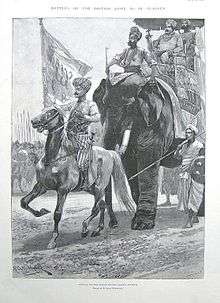Battle of Buxar
| Battle of Buxar | |||||||
|---|---|---|---|---|---|---|---|
| Part of Bengal War | |||||||
 | |||||||
| |||||||
| Belligerents | |||||||
|
| ||||||
| Commanders and leaders | |||||||
|
| |||||||
| Strength | |||||||
|
40,000 140 cannons |
7,072 30 cannons | ||||||
| Casualties and losses | |||||||
|
Disputed British claim:[2] 2,000 killed | 733-847 killed, wounded or missing [2][3] | ||||||
The Battle of Buxar was fought on 22 October 1764 between the forces under the command of the British East India Company led by Hector Munro and the combined armies of Mir Qasim, the Nawab of Bengal; the Nawab of Awadh; and the Mughal Emperor Shah Alam II.[4] The battle fought at Buxar, a "small fortified town" within the territory of Bengal, located on the banks of the Ganges river about 130 kilometres (81 mi) west of Patna, was a decisive victory for the British East India Company.
Battle
The British army engaged in the fighting numbered 7,071[5] comprising 857 British, 5,297 Indian sepoys and 918 Indian cavalry. The alliance army's numbers were estimated to be over 40,000. According to other sources, the combined army of the Mughals, Awadh and Mir Qasim consisting of 40,000 men was defeated by a British army comprising 10,000 men.
The lack of basic co-ordination among the three disparate allies was responsible for their decisive defeat.
Mirza Najaf Khan commanded the right flank of the Mughal imperial army and was the first to advance his forces against Major Hector Munro at daybreak; the British lines formed within twenty minutes and reversed the advance of the Mughals. According to the British, Durrani and Rohilla cavalry were also present and fought during the battle in various skirmishes. But by midday, the battle was over and Shuja-ud-Daula blew up large tumbrils and three massive magazines of gunpowder.
Munro divided his army into various columns and particularly pursued the Mughal Grand Vizier Shuja-ud-Daula the Nawab of Awadh, who responded by blowing up his boat-bridge after crossing the river, thus abandoning the Mughal Emperor Shah Alam II and members of his own regiment. Mir Qasim also fled with his 3 million rupees worth of Gemstones and later committed suicide. Mirza Najaf Khan reorganised formations around Shah Alam II, who retreated and then chose to negotiate with the victorious British.
Historian John William Fortescue claimed that the British casualties totalled 847: 39 killed and 64 wounded from the European regiments and 250 killed, 435 wounded and 85 missing from the East India Company's sepoys.[2] He also claimed that the three Indian allies suffered 2,000 dead and that many more were wounded.[2] Another source says that there were 69 European and 664 sepoy casualties on the British side and 6,000 casualties on the Mughal side.[3] The victors captured 133 pieces of artillery and over 1 million rupees of cash. Immediately after the battle Munro decided to assist the Marathas, who were described as a "warlike race", well known for their relentless and unwavering hatred towards the Mughal Empire and its Nawabs and the Sultanate of Mysore.
Aftermath
The British victory at Buxar had "at one fell swoop, disposed of the three main scions of Moghul power in Upper India. Mir Kasim [Qasim] disappeared into an impoverished obscurity. Shah Alam realigned himself with the British, and Shah Shuja [Shuja-ud-Daula] fled west hotly pursued by the victors. The whole Ganges valley lay at the Company's mercy; Shah Shuja eventually surrendered; henceforth Company troops became the power-brokers throughout Oudh as well as Bihar".[6]
Gallery

 The Nawab of Bengal, Mir Qasim
The Nawab of Bengal, Mir Qasim Shuja-ud-Daula served as the leading Nawab Vizier of the Mughal Empire, he was a lifelong of Shah Alam II.
Shuja-ud-Daula served as the leading Nawab Vizier of the Mughal Empire, he was a lifelong of Shah Alam II. Mirza Najaf Khan Baloch, the commander-in-chief of the Mughal Army.
Mirza Najaf Khan Baloch, the commander-in-chief of the Mughal Army. Political map of the Indian Subcontinent in the year 1765.
Political map of the Indian Subcontinent in the year 1765.
See also
References
- 1 2 History of the Freedom Movement in India (1857–1947), p. 2, at Google Books
- 1 2 3 4 Fortescue, John William. (2004). A History of the British Army: Volume III. p. 102. The Naval and Military Press. Uckfield, Sussex. ISBN 978-1843427155.
- 1 2 Black, Jeremy and Wyse, Liz. (1996). The Cambridge Illustrated Atlas of Warfare: Renaissance to Revolution, 1492-1792. p. 160. The Cambridge University Press. ISBN 9780521470339.
- ↑ Parshotam Mehra (1985). A Dictionary of Modern History (1707–1947). Oxford University Press. ISBN 0-19-561552-2.
- ↑ Sir Edward Cust, Annals of the Wars of the Eighteenth Century, Vol. 3, p. 113, at Google Books, Mitchell's Military Library (1858). ISBN 1235663922
- ↑ Keay, John. (1993). The Honourable Company: A History of the English East India Company. Paperback edition. p. 374. HarperCollins Publishers. London. ISBN 978-0-00-638072-6.
External links